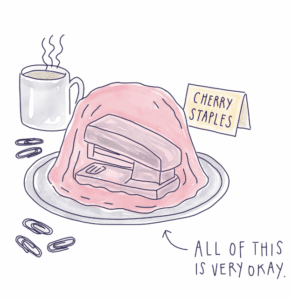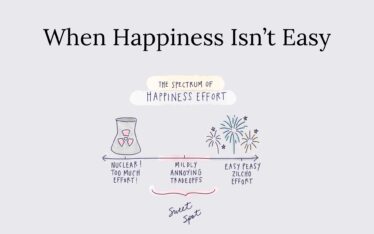There are few things I love more than a practical joke: salty caramel sauce, a cat who gives me bedroom eyes, when anyone anywhere says they like my book, The Husband, the first sip of wine—although not necessarily in that order. I’m partially convinced our lives are pranks being pulled by a superior (and wittier) species from another galaxy (that would explain so many things, right? Like why websites we visit all the time “do not recognize this device” on the laptop we visit said websites with all the time? *cue alien snickering*).
I like to research things I enjoy doing, so as to validate how and why they might be good for me. (I have been coming up empty with the “drinking magnums of wine is super good for my health and longevity” evidence these days; can I gently encourage the alcohol industry lobbyists to sponsor more studies to support this claim? I prefer drinking with a delusional buzz.)
Back to the practical jokes, though! I corralled a bunch of studies that agreed with me about how practical jokes can be tiny interventions for social and emotional health—good for the victim target, and (quietly) great for the prankster. (I originally wrote this piece for Psychology Today so it has an ironically less-fun tone than what is normal for me, but what the hell. Sometimes the jokester has to clean up her act.)
Why jokes can be called “prosocial mischief”
 Humor researchers argue that something is funny when it’s both a “violation” and clearly benign—a safe breach of expectation (e.g., the stapler that’s been Jell-O-molded but unharmed, the Zoom background that turns your colleague’s office into a moon base). This benign-violation notion helps distinguish playful pranks from hurtful ones and explains why the same gag lands in one relationship and flops in another.
Humor researchers argue that something is funny when it’s both a “violation” and clearly benign—a safe breach of expectation (e.g., the stapler that’s been Jell-O-molded but unharmed, the Zoom background that turns your colleague’s office into a moon base). This benign-violation notion helps distinguish playful pranks from hurtful ones and explains why the same gag lands in one relationship and flops in another.
Power and psychological distance matter, too: humor works best when there isn’t a power imbalance and when the “violation” feels safely distant from core identities or risks. In short: the ground rule for practical jokes is radical safety.
Measurable upsides for relationships
Laughter isn’t just pleasant; it’s bonding. In a study of romantic partners recalling their “how we met” story, shared laughter (not just total laughter) strongly indexed relationship quality and perceived closeness.
In groups, laughter elevates pain thresholds—an indirect marker of endogenous opioid activity—suggesting a neurochemical pathway for social glue. A PET study later confirmed that social laughter triggers endogenous opioid release in brain regions tied to reward and bonding. Harmless practical jokes—because they engineer a small surprise followed by shared amusement—can create precisely these co-laughter moments that tighten ties.
Benefits for the “victim”… and the joker
When the bit is safe and affiliative (vs. put-down or aggressive), it sits in the humor styles linked with better well-being and relationship satisfaction. Think of it as playful teasing that affirms membership (“you’re one of us, Rookie!”) rather than undermines status. For the plotter, there’s more than a giggle payoff:
- Anticipatory savoring. Designing a playful reveal builds a period of positive anticipation. Savoring—mentally up-regulating the enjoyment of future, present, or past positives—reliably boosts positive emotion. The planning phase of a gentle prank is essentially a micro-savoring intervention for the joker.
- Prosocial intent. Positive activities aimed at others (e.g., acts of kindness) increase well-being, in part by strengthening social connection and a sense of efficacy. While a prank isn’t a kindness per se, prosocial pranks—designed to delight, not embarrass—can operate via similar mechanisms: creating shared joy and social reciprocity.
- Stress physiology. Classic work shows mirthful laughter reduces cortisol, epinephrine, and other stress markers, and a recent meta-analysis finds spontaneous laughter is associated with larger cortisol reductions than typical activities. If a light prank culminates in genuine laughter across the group, everyone gets a little stress reprieve.
How to keep the “benign” in benign violation
- Know your audience and their non-negotiables. Avoid identities, vulnerabilities, and reputational risk. When in doubt, don’t.
- Punch sideways (or up), never down. Power asymmetries make jokes riskier and less likely to feel benign. Maybe don’t fill the intern’s car with Styrofoam peanuts on day one, for example.
- Make restitution part of the gag. Anything moved, “kidnapped,” or rearranged is returned promptly; clean-up is on you.
- Engineer a quick reframe. The reveal should rapidly signal safety and inclusion (“We made you a fake award,” not “We put your performance on blast”).
- End with shared celebration. A team muffin run or a silly certificate converts surprise into communal positive affect—exactly the conditions under which laughter bonds.
Lastly… a positive psychology take
In organizational and clinical contexts, micro-moments of positive emotion build resources over time—resilience, trust, and broadened cognition (yes! Broaden-and-build theory!). Affiliation-focused humor and light playfulness are not trivial; they’re repeatable, low-dose practices that accumulate. Well-designed practical jokes, used sparingly and ethically, can serve as micro-interventions: they increase the rate of shared laughter (relationship marker), generate savoring for planners (emotion-regulation), and can downshift stress physiology for the whole group. The bar is not whether a prank gets laughs; the bar is whether it deepens belonging without collateral damage.
If you’re leading teams: give them a simple checklist—Is it safe? Reversible? Inclusive? Brief? Followed by recognition?—and invite them to test a one-minute, zero-mess gag (e.g., faux “VIP Reserved” desk sign) followed by a treat and a real compliment. The science suggests those tiny “benign violations,” handled with care, can be surprisingly wholesome.
So what are you waiting for? Get your master plan in place and practical joke away. Prank permission has been granted 😉.

P.S.: Have you read my book, You Only Die Once: How to Make It to the End with No Regrets? No? C’mon, you’re joking me, right? This is a prank?
P.P.S.: Let’s connect on Instagram.
P.P.P.S.: Oh and just in case you missed it… I’d love you forever if you took 16 minutes out of your life to watch my TEDx talk!






